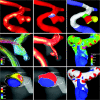Quantitative characterization of the hemodynamic environment in ruptured and unruptured brain aneurysms
- PMID: 21127144
- PMCID: PMC3086563
- DOI: 10.3174/ajnr.A2419
Quantitative characterization of the hemodynamic environment in ruptured and unruptured brain aneurysms
Abstract
Background and purpose: Hemodynamics are thought to play an important role in the mechanisms of aneurysm pathogenesis, progression, and rupture. The purpose of this study was to define quantitative measures related to qualitative flow characteristics previously analyzed and to investigate their relationship to aneurysm rupture.
Materials and methods: The hemodynamic environments in 210 cerebral aneurysms were analyzed by using image-based CFD under different flow conditions. Quantitative hemodynamic variables were defined and extracted from the simulation results. A statistical analysis of the relationship to the previous history of aneurysm rupture was performed, and the variability with flow conditions was assessed.
Results: Ruptured aneurysms were more likely to have larger inflow concentrations, larger MWSS, larger shear concentrations, and lower viscous dissipation ratios than unruptured aneurysms. Areas under low WSS and measures of abnormally low shear force distributions of ruptured and unruptured aneurysms were not statistically different. Although the values of hemodynamic quantities changed with different flow conditions, the statistical differences or ratios between their mean values over the ruptured and unruptured groups were maintained, for both pulsatile and steady flows.
Conclusions: Concentrated inflow streams and WSS distributions with elevated levels of MWSS and low aneurysmal viscous dissipation are statistically associated with a clinical history of prior aneurysm rupture. In contrast, the area and total viscous shear force applied in the aneurysm region subjected to abnormally low WSS levels are not. This study highlights the potential for image-based CFD for investigating aneurysm-evolution mechanisms and for clinical assessment of aneurysm risks.
Figures



Similar articles
-
Association of hemodynamic characteristics and cerebral aneurysm rupture.AJNR Am J Neuroradiol. 2011 Feb;32(2):264-70. doi: 10.3174/ajnr.A2274. Epub 2010 Nov 4. AJNR Am J Neuroradiol. 2011. PMID: 21051508 Free PMC article.
-
Patient-specific hemodynamic analysis of small internal carotid artery-ophthalmic artery aneurysms.Surg Neurol. 2009 Nov;72(5):444-50; discussion 450. doi: 10.1016/j.surneu.2008.12.013. Epub 2009 Mar 29. Surg Neurol. 2009. PMID: 19329152
-
Local hemodynamics at the rupture point of cerebral aneurysms determined by computational fluid dynamics analysis.Cerebrovasc Dis. 2012;34(2):121-9. doi: 10.1159/000339678. Epub 2012 Aug 1. Cerebrovasc Dis. 2012. PMID: 22965244
-
Hemodynamics in a Middle Cerebral Artery Aneurysm Before Its Growth and Fatal Rupture: Case Study and Review of the Literature.World Neurosurg. 2018 Nov;119:e395-e402. doi: 10.1016/j.wneu.2018.07.174. Epub 2018 Jul 30. World Neurosurg. 2018. PMID: 30071328 Review.
-
High WSS or low WSS? Complex interactions of hemodynamics with intracranial aneurysm initiation, growth, and rupture: toward a unifying hypothesis.AJNR Am J Neuroradiol. 2014 Jul;35(7):1254-62. doi: 10.3174/ajnr.A3558. Epub 2013 Apr 18. AJNR Am J Neuroradiol. 2014. PMID: 23598838 Free PMC article. Review.
Cited by
-
Hemodynamic and Morphological Analysis of Mirror Aneurysms Prior to Rupture.Neuropsychiatr Dis Treat. 2020 May 27;16:1339-1347. doi: 10.2147/NDT.S254124. eCollection 2020. Neuropsychiatr Dis Treat. 2020. PMID: 32547037 Free PMC article.
-
Reliability and accuracy assessment of morphometric measurements obtained with software for three-dimensional reconstruction of brain aneurysms relative to cerebral angiography measures.Interv Neuroradiol. 2021 Apr;27(2):191-199. doi: 10.1177/1591019920961588. Epub 2020 Sep 30. Interv Neuroradiol. 2021. PMID: 32996346 Free PMC article.
-
Comparison of computational fluid dynamics findings with intraoperative microscopy findings in unruptured intracranial aneurysms- An initial analysis.Asian J Neurosurg. 2016 Oct-Dec;11(4):356-360. doi: 10.4103/1793-5482.180962. Asian J Neurosurg. 2016. PMID: 27695537 Free PMC article.
-
Unruptured intracranial aneurysms: development, rupture and preventive management.Nat Rev Neurol. 2016 Dec;12(12):699-713. doi: 10.1038/nrneurol.2016.150. Epub 2016 Nov 3. Nat Rev Neurol. 2016. PMID: 27808265 Review.
-
A non-dimensional parameter for classification of the flow in intracranial aneurysms. II. Patient-specific geometries.Phys Fluids (1994). 2019 Mar;31(3):031905. doi: 10.1063/1.5081451. Epub 2019 Mar 26. Phys Fluids (1994). 2019. PMID: 30967745 Free PMC article.
References
-
- Kassell NF, Torner JC, Haley EC, et al. . The International Cooperative Study on the Timing of Aneurysm Surgery. Part 1. Overall management results. J Neurosurg 1990;73:18–36 - PubMed
-
- Wiebers DO, Whisnant JP, Huston J, 3rd, et al. , for the International Study of Unruptured Intracranial Aneurysms Investigators. Unruptured intracranial aneurysms: natural history, clinical outcome, and risks of surgical and endovascular treatment. Lancet 2003;362:103–10 - PubMed
-
- Tomasello F, D'Avella D, Salpietro FM, et al. . Asymptomatic aneurysms: literature meta-analysis and indications for treatment. J Neurosurg Sci 1998;42:47–51 - PubMed
-
- Nishioka H, Torner JC, Graf CJ, et al. . Cooperative study of intracranial aneurysms and subarachnoid hemorrhage: a long-term prognostic study. II. Ruptured intracranial aneurysms managed conservatively. Arch Neurol 1984;41:1142–46 - PubMed
-
- White PM, Wardlaw JM. Unruptured intracranial aneurysms. J Neuroradiol 2003;30:336–50 - PubMed
Publication types
MeSH terms
Grants and funding
LinkOut - more resources
Full Text Sources
Other Literature Sources
Medical
Research Materials
Miscellaneous
